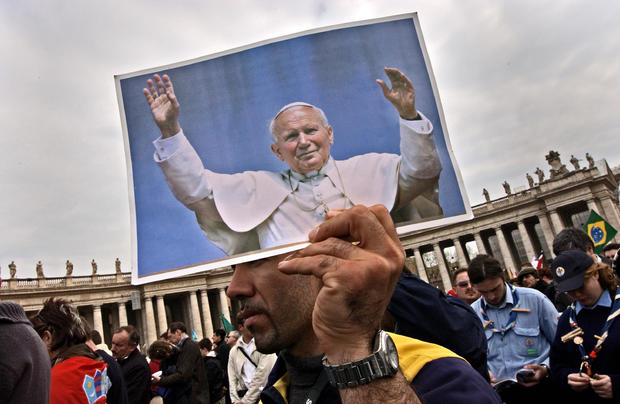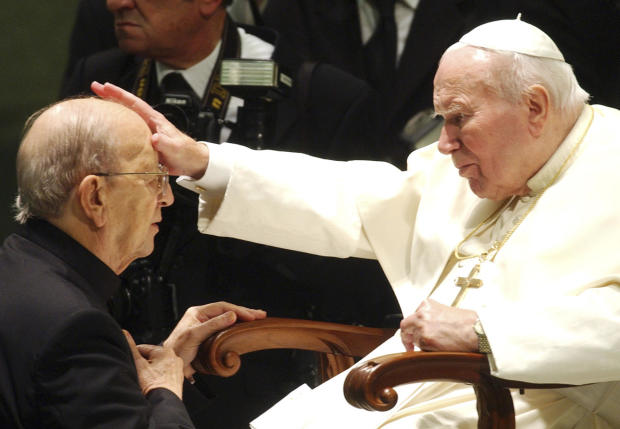Saint John Paul II accused of protecting pedophiles, fueling debate over late pope’s “fast-track” to sainthood
Rome — A documentary hit the airwaves this week in Poland alleging the former pope, Saint John Paul II, protected pedophile priests when he was Archbishop of Krakow in his native country. It has reignited a long-standing debate over whether John Paul II was made a saint too quickly.
The report aired this week by Polish broadcaster TVN24 accuses John Paul of allowing three priests to continue working in the church in the 1970s despite knowing they had been accused of abusing minors. Two of the priests eventually served prison terms for their crimes.
Alessandra Benedetti/Corbis/Getty
Calls for John Paul II to be made a saint began at his funeral, on April 2, 2005, when cries of “Santo Subito” (or “sainthood immediately”) erupted from the half million pilgrims in St. Peter’s Square at the Vatican. Many held up banners calling for his sainthood.
The cries didn’t fall on deaf ears. Just days after his death, the Vatican began the process of making him a saint. He was “beatified” only six years later and then “canonized” — formally declared a saint — just three years after that. It was the fastest canonization in the history of the Catholic Church.
“Quick canonizations are problematic,” Father Thomas Reese, a Jesuit priest and author, told CBS News. “It is better to have a cooling off period to see if the person’s reputation stands up over time. It takes time to do the research into a person’s life and writings to make sure that his or her life matches the criteria for sainthood.”
Since 1588, when the Vatican established an official saint-making office, the average time between death and sainthood has been about 181 years. That long post-mortem period ensured that would-be saint’s lives were thoroughly scrutinized.
But the Polish pontiff made significant changes to the church’s sainthood rules during his time as pope, reducing the number of years before the process could even begin following a candidate’s death from 50 to just five.
But in John Paul’s case, his successor Pope Benedict XVI waived even that reduced period. John Paul also reduced the number of posthumous miracles required for sainthood, from four to two. Finally, he eliminated the role of the “advocatus diaboli,” or devil’s advocate, whose role it had long been to critically examine a candidate’s life and miracles, and to argue against their sainthood, though the Vatican can and does still solicit opposing testimony during the sainthood process.
“John Paul II’s fast-track to sainthood was a product of his own reforms,” John Allen, editor of Catholic website Crux and author of 11 books on Catholicism, told CBS News. “During his papacy, John Paul wanted to make the process faster, cheaper and less adversarial. As a result, he not only canonized and beatified more people than any previous pope, but more than all previous popes combined.”
The majority of these 482 new saints were figures from the 20th century, “reflecting John Paul’s conviction that the church needed role models of holiness from our own time,” Allen said.
The reforms opened up the Vatican to criticism that it was turning into a “sainthood factory,” and abandoning its long-held critical standards, Allen said, noting that critics had “warned that the waiting period, for example, was intended to prevent a rush to judgment, and that there might be cases of fast-track halos the church would end up regretting. Ironically, some are now saying that about John Paul’s own sainthood.”
Supporters of John Paul’s shortest-ever journey to sainthood say he lived a life of heroic virtue and exceptional holiness, the first requirement for sainthood. He helped bring down communism, repaired relations with Judaism and brought a new generation of worshippers into the church. But his detractors say the pope’s reputation hasn’t withstood the test of time, particularly when it comes to his record on clerical sex abuse.
John Paul II “was indeed rushed to sainthood,” in the opinion of Michael McDonnell, the head of communications for the Survivors Network of Those Abused by Priests (SNAP). “He was embraced globally for his travels and credited for helping to end communism in his very Catholic homeland. These achievements provided great cover for him during a time when clergy abuse revelations were steamrolling in the United States and beginning to appear globally.”
The late pope’s canonization, McDonnell said, poured more salt on the still-raw wounds of abuse victims.
Plinio Lepri/AP
Accusations of failures to take action span across John Paul’s 26-year papacy. He refused to believe accusations against Father Marcial Maciel Degollado, the founder of the Legionnaires of Christ order and one of the church’s greatest fundraisers. Those accusations started surfacing in the late 1970s and continued for decades. Maciel was eventually found to have sexually abused minors and seminarians, and to have fathered several children, who he also abused.
In 2004, two years after disgraced Boston archbishop Cardinal Bernard Law was forced to resign because he’d protected pedophile priests, John Paul appointed him to a prestigious post in Rome.
In 2020, in a stunning admission, the Catholic church said John Paul II had ignored warnings about former Cardinal Theodore McCarrick from as far back as 1999, instead raising him to the powerful position of Archbishop of Washington D.C. McCarrick has since been defrocked and is under criminal prosecution in Massachusetts for alleged sexual abuse of minors.
“Canonization does not mean that the person was perfect, that they never did anything wrong, that they never sinned,” said Reese. “They are people of their times with many of the blind spots and even prejudices of their times. Many aspects of their lives can be admired and imitated while at the same time recognizing that they made mistakes and even sinned.”
Allen said canonization was “a finding that despite whatever human failures or limitations in judgment his papacy may have reflected, there was nevertheless a genuine holiness of life about the person of the pope. Undoubtedly, supporters of John Paul II will say the same thing vis-à-vis his record on the abuse crisis.”
For all the latest Automobiles News Click Here
For the latest news and updates, follow us on Google News.



